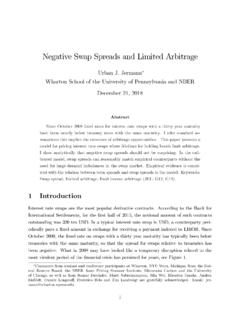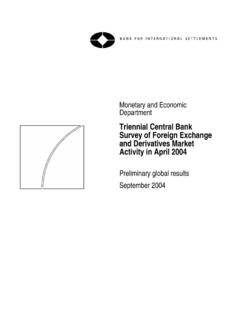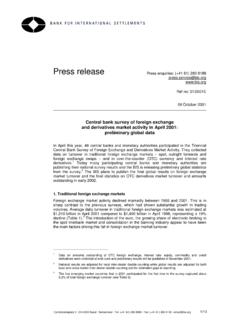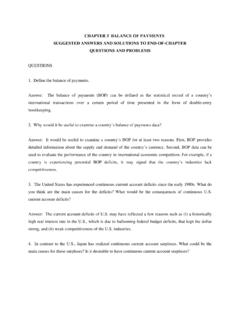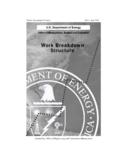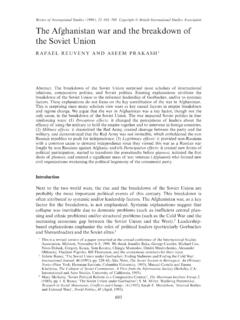Transcription of Appendix 5A The Term Structure of Interest Rates, Spot ...
1 Chapter 5 How to Value Bonds and Stocks 5A-1 The Term Structure of Interest Rates, Spot Rates, and Yield to MaturityIn the main body of this chapter, we have assumed that the Interest rate is constant over all future periods. In reality, Interest rates vary through time. This occurs primarily because infl ation rates are expected to differ through time. To illustrate, we consider two zero coupon bonds. Bond A is a one-year bond and bond B is a two-year bond. Both have face values of $1,000. The one-year Interest rate, r1, is 8 per-cent. The two-year Interest rate, r2, is 10 percent. These two rates of Interest are examples of spot rates. Perhaps this inequality in Interest rates occurs because infl ation is expected to be higher over the second year than over the fi rst year.
2 The two bonds are depicted in the following time chart:28%Bond A$1,00010%Bond B$1,00010 Year 1 Year 2 We can easily calculate the present value for bond A and bond B as follows: PVA $ $1,000 _____ PVB $ $1,000 _____ ( )2 Of course, if PVA and PVB were observable and the spot rates were not, we could determine the spot rates using the PV formula, because: PVA $ $1,000 _____ (1 r1) r1 8%and: PVB $ $1,000 _____ (1 r2)2 r2 10%Now we can see how the prices of more complicated bonds are determined. Try to do the next example. It illustrates the difference between spot rates and yields to the Spot Given the spot rates r1 equals 8 percent and r2 equals 10 percent, what should a 5 percent coupon, two-year bond cost?
3 The cash fl ows C1 and C2 are illustrated in the following time chart:28%$5010%$1,05010 Year 1 Year 2 The bond can be viewed as a portfolio of zero coupon bonds with one- and two-year maturities. Therefore: PV $50 _____ 1 $1,050 _____ (1 )2 $ ( )(continued) 110/31/06 11:33:33 AM10/31/06 11:33:33 AM5A-2 Part II Valuation and Capital BudgetingGraphing the Term Structure The term Structure describes the relationship of spot rates with different maturities. Figure graphs a particular term Structure . In Figure the spot rates are increasing with longer maturities that is, r3 r2 r1. Graphing the term Structure is easy if we can observe spot rates.
4 Unfortunately this can be done only if there are enough zero coupon government given term Structure , such as that in Figure , exists for only a moment in time say 10:00 , July 30, 2006. Interest rates are likely to change in the next minute, so that a different (though quite similar) term Structure would exist at 10:01 now want to calculate a single rate for the bond. We do this by solving for y in the following equation: $ $50 _____ 1 y $1,050 _____ (1 y)2 ( )In Equation , y equals percent. As mentioned in the chapter, we call y the yield to maturity on the bond. Solving for y for a multiyear bond is generally done by means of trial and Although this can take much time with paper and pencil, it is virtually instantaneous on a handheld calculator.
5 It is worthwhile to contrast Equations and In , we use the marketwide spot rates to determine the price of the bond. Once we get the bond price, we use to calculate its yield to maturity. Because Equation employs two spot rates whereas only one appears in , we can think of yield to maturity as some sort of average of the two spot Using these spot rates, the yield to maturity of a two-year coupon bond whose coupon rate is 12 percent and PV equals $1, can be determined by:$1, $120 _____ 1 r $1,120 _____ (1 r)2 r these calculations show, two bonds with the same maturity will usually have different yields to maturity if the coupons quadratic formula may be used to solve for y for a two-year bond.
6 However, formulas generally do not apply for bonds with more than four payment to maturity is not a simple average of r1 and r2. Rather, fi nancial economists speak of it as a time-weighted average of r1 and interestrates (%)Time (years)234567 Figure Term Structure of Interest 210/31/06 11:33:36 AM10/31/06 11:33:36 AM Chapter 5 How to Value Bonds and Stocks 5A-3 Explanations of the Term StructureFigure showed one of many possible relationships between the spot rate and maturity. We now want to explore the relationship in more detail. We begin by defi ning a new term, the forward rate. Next, we relate this forward rate to future Interest rates. Finally we con-sider alternative theories of the term nition of Forward Rate Earlier in this Appendix , we developed a two-year example where the spot rate over the fi rst year is 8 percent and the spot rate over the two years is 10 percent.
7 Here, an individual investing $1 in a two-year zero coupon bond would have $1 ( )2 in two years. To pursue our discussion, it is worthwhile to rewrite:3 $1 ( )2 $1 ( )Equation tells us something important about the relationship between one- and two-year rates. When an individual invests in a two-year zero coupon bond yielding 10 percent, his wealth at the end of two years is the same as if he received an 8 percent return over the fi rst year and a percent return over the second year. This hypothetical rate over the second year, percent, is called the forward rate. Thus, we can think of an investor with a two-year zero coupon bond as getting the one-year spot rate of 8 percent and lock-ing in percent over the second year.
8 This relationship is presented in Figure More generally, if we are given spot rates r1 and r2, we can always determine the forward rate, f2, such that: (1 r2)2 (1 r1) (1 f2) ( )We solve for f2, yielding: f2 (1 r2)2 _____ 1 r1 1 ( )Figure of a Two-Year Spot Rate into a One-Year Spot Rate and Forward Rate over the Second Year210%$1$1 ( )2 $ 1 Year 2 DateWith a two-year spot rate of 10 percent, an investor in two-year bond receives $ at date is the same return as if the investor received the spot rate of 8 percent over the fi rst year and a percent return over the second year.$1 8% $ $1 $ both the one-year spot rate and the two-year spot rate are known at date 0, the forward rate over the second year can be calculated at date percent is equal to: ( )2 _____ ( ) 1when rounding is performed after four 310/31/06 11:33:37 AM10/31/06 11:33:37 AM5A-4 Part II Valuation and Capital BudgetingEXAMPLE Forward If the one-year spot rate is 7 percent and the two-year spot rate is 12 percent, what is f2?
9 We plug in Equation , yielding: f2 ( )2 _____ 1 Consider an individual investing in a two-year zero coupon bond yielding 12 percent. We say it is as if he receives 7 percent over the fi rst year and simultaneously locks in percent over the second year. Note that both the one-year spot rate and the two-year spot rate are known at date 0. Because the forward rate is calculated from the one-year and two-year spot rates, it can be calculated at date 0 as well. Forward rates can be calculated over later years as well. The general formula is: fn (1 rn)n _____ (1 rn 1)n 1 1 ( )where fn is the forward rate over the nth year, rn is the n-year spot rate, and rn 1 is the spot rate for n 1 Rates Assume the following set of rates:YearSpot Rate15%263746 What are the forward rates over each of the four years?
10 The forward rate over the fi rst year is, by defi nition, equal to the one-year spot rate. Thus, we do not generally speak of the forward rate over the fi rst year. The forward rates over the later years are: f2 ( )2 _____ 1 f3 ( )3 _____ ( )2 1 f4 ( )4 _____ ( )3 1 An individual investing $1 in the two-year zero coupon bond receives $ [$1 ( )2] at date 2. He can be viewed as receiving the one-year spot rate of 5 percent over the first year and receiving the forward rate of percent over the second year. An individual investing $1 in a three-year zero coupon bond receives $ [$1 ( )3] at date 3. She can be viewed as receiving the two-year spot rate of 6 percent over the first two years and receiving the forward rate of percent over the third year.

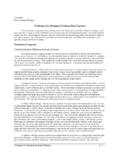

![Dif In Dif Slides.ppt [Repaired] - Wharton Finance](/cache/preview/e/2/9/5/4/6/1/8/thumb-e29546186543c246a2365bc5cbc8c9a4.jpg)
